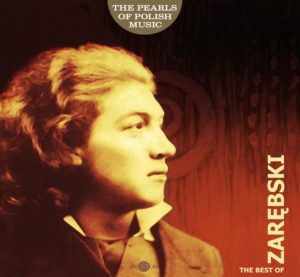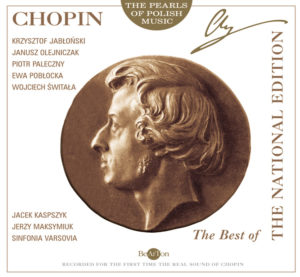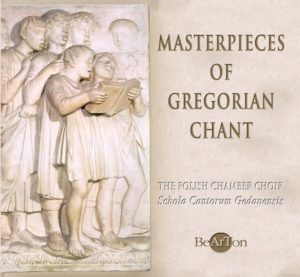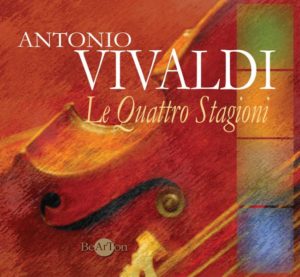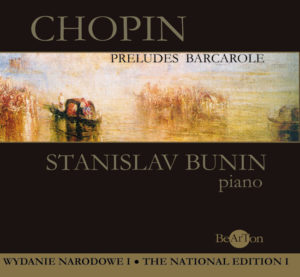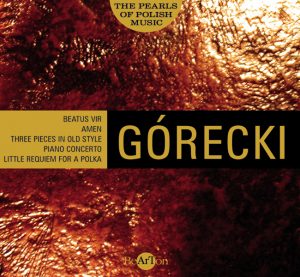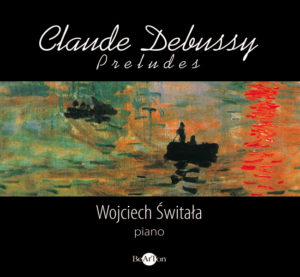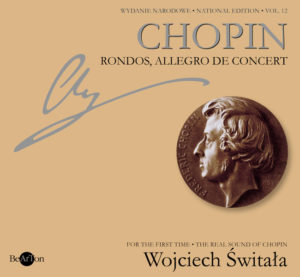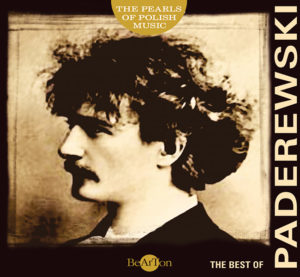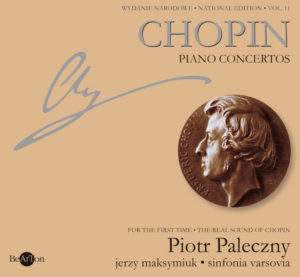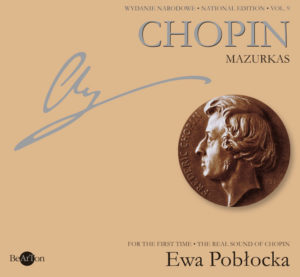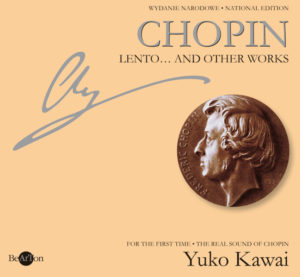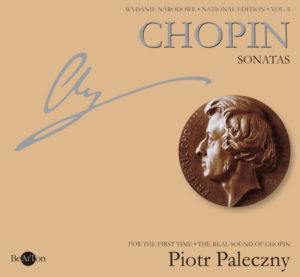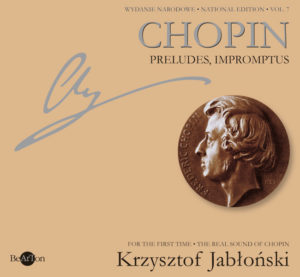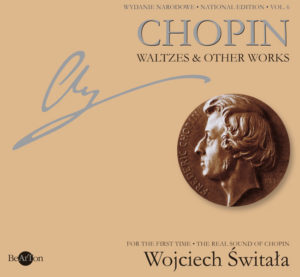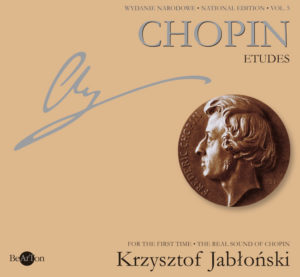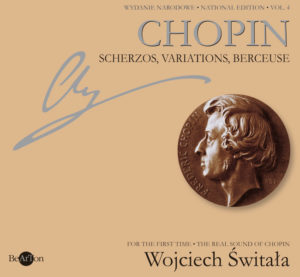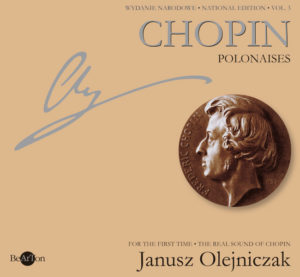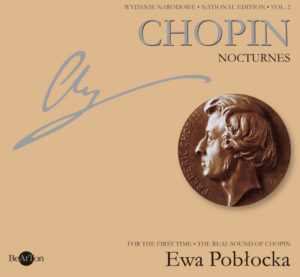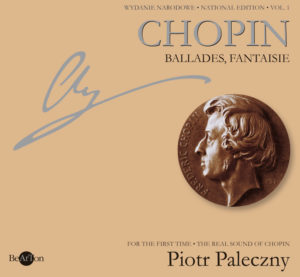Chopin – Waltzes [B] and other works
Chopin – Waltzes [B] and other works
Cat. No. CDB047
Music disc: SACD
Performer:
Janusz Olejniczak – fortepian
Disc content
- Waltz in E major WN 18 – 2’29”
- Waltz in B minor WN 19 – 2’39”
- Waltz in Db major WN 20 – 2’43”
- Waltz in Ab major WN 28 – 1’12”
- Waltz in E minor WN 29 – 2’50”
- Waltz in Gb major WN 42 – 2’05”
- Waltz in Ab major WN47 – 3’18”
- Waltz in F minor WN 55 – 3’08”
- Waltz in A minor WN 63 – 2’28”
- Waltz in A minor Op. 34 No.2 – 5’22”
- Waltz in D flat major Op. 64 No. 1 – 1’42”
- Waltz in C sharp minor Op. 64 No.2 – 3’35”
- Impromptu in C sharp minor WN 46 [First version] – 4’23”
- Andante spianato and Grand Polonaise in E flat major Op. 22 – 13’16”
Total time – 51’59”
Listen a part
51.99złAdd to basket
© ℗ 2009 Bearton
Waltzes [B] and Other Works
Another album of Series B dedicated to Waltzes contains more than the nine pieces of the genre published after the composer’s death. Their short duration created an opportunity to supplement the recording repertoire of the National Edition cycle by the pieces which were missing before: Impromptu in C sharp minor, No. WN 46, from the Various Works volume and the Andante spianato and Polonaise in E flat major, Op. 22, in the version for one piano. In addition to those compositions, the album also contains selections made by the performing artist: Waltzes in A minor, Op. 34, No. 2, D flat major and C sharp minor, from Op. 64.
The Waltzes belong to those pieces which are most frequently published and highly appreciated.[…] Chopin’s waltzes go back to a number of models, with the earliest reaching out to the waltz tradition existing in Poland. One can say that Chopin’s generation „grew up” in the rhythm of the Viennese waltz in its native issue. The characteristics of that issue, which was a popular dance at that time called the walcerek, included frequent use of the lendler rhythms, next to the rhythmics of the oberek and the mazurka. Chopin frequently heard waltzes of the popular, urban or court types, played at balls or social meetings. He was also well abreast with the Austrian and Viennese traditions. […]Chopin divided his waltzes into two separate groups: social and concert waltzes. All the pieces published after the composer’s death belong to the former group, which hardly depreciates their value, the more so as the boundaries between the two types are often blurred.
The first five pieces recorded on our album originate from Chopin’s Warsaw period, while the remaining four were written in Paris. The Warsaw Waltzes were probably composed in 1829 [the dates of origin are quoted here after the National Edition]. The Waltzes in E major, No. WN18, and A flat major, No. WN 28, were the first attempts at trying out the dance form convention, with a separated trio, representing usable music formed in accordance with the Polish model mentioned before (Waltz in A flat minor, in particular). The next three waltzes composed in Poland and most certainly after Chopin’s first stay in Vienna (1829), reveal Chopin’s personal stylistic idiom. The middle part of Waltz in B minor, No. WN 19, similarly to the trio of Waltz in D flat major, No. WN 20, saturated with passion, proclaim the mature lyrics of the Paris Waltzes. Our selection of waltzes is adorned by Waltz in E minor, No. WN 29, of 1830, one of the most precious manifestations of Chopin’s invention of that time. According to some specialists, the composer left far behind the striking waltz stylisation of Weber’s Invitation to Dance. Chopin’s waltz was probably the first concert waltz, with an introduction and a coda, full of pianist glitter and swing. Behind the waltz’s virtuoso faćade, there is a new expression with a strongly Romantic nature. In fact, that is a ballade-waltz, with the theme suggesting a colourful poetic story supplemented by a contrast of unique brightness in the trio, being a unique anticipation of the later dance poems.
The Paris Waltzes of the social type are not uniform in composition. The succinct Waltz in G flat major, No. WN 42, of 1832, associates the virtuoso element with singing lyrics, while Waltz in A flat major, No. WN 48, is an expressive example of a separate dance variation, combining the rhythms of the waltz and the mazurka. The melancholic 1841 Waltz in F minor, No. WN 55, inserted in many albums, represents typical compositions of the private type, while the standard Waltz in A minor, No. WN 63, composed together with the Sonata, Op. 65, and other pieces in 1847-1849, contains that profound sadness of the composer’s „final style.”

Janusz Olejniczak
The next three pieces presented in our album belong to the Paris concert waltz type. They are different in nature and form from the usable and occasional dances and belong to the so-called dance poems. Waltz in A minor, from Op. 34, No. 2, is of the melancolique type. Even the very waltz rhythm stylisation, in the form of a slow and lyrical piece, is a novelty, and, starting with the introduction which oscillates around one sound, the composition develops along original narration. It suits the expression of emotional contents and a profound sadness, presented in a strong, suggestive manner, distant from salons’ banality. Also, the sophisticated harmonic and acoustic language applied by the artist protects the piece against that type of banality. A light and humorous Waltz in D flat major, Op. 64, No. 1, called the Minute Waltz, dedicated to Delfina Potocka, composed probably in 1840, was added to Op. 64 seven years later. Based on the formula of fast repetition of selected sounds, it reminds of the country musicians’ style when playing the oberek. However, in Chopin’s case, the composer’s intention was not to dazzle one with a folk performance manner, but rather to create a cheerful, „refined” and virtuoso miniature at an advanced artistic level. Owing to that sophisticated invention, subtle harmonica and unique colour, we obtained the composer’s one of the most popular waltzes, being not only glamorous but also prominent. Waltz in C sharp minor, Op. 64, No. 2, is the crown of the mélancolique waltzes. It is considered to be Chopin’s most beautiful piece in respect of both poetic content and types of melodic and harmonic conceptions. Exquisite and brave harmonics implies superb sound colours in comparison to the previous pieces of that type; the colours being soft and subtle, sensitive and sophisticated. The personal and lyrical tone, with the shade of painful sadness, pity, or possibly elegiac musing, places the piece rather among nocturnal compositions than Viennese dance stylization.
Improptus in C sharp minor, No. WN 46, were written in Paris in 1834. The title [meaning improvisations in Latin] refers to a composition intended to seize spontaneously a momentary and transient mood, in accordance with Romantic aesthetics. Chopin took that title from F. Schubert and I. Moscheles, as adequate in this case for a piece bereaved of dramatic tensions and filled with serene lyricism, and, at the same time stunning, swift and striking in performance. What is characteristic for the Impromptus is the application of polymetry in almost the whole piece: the right hand playing the paired rhythm, while the left one the ternary one (sextole). That type of rhythmic independence was used in piano music as a transitional effect, and it was an unusually brave novelty at that time. It was not the only original feature of that charming composition. Swift, extreme sixteenth parts contrasted with the middle part, being broad and dreamy cantilena of nocturnal origin, while the piece was concluded with a coda of a particular sound colour owing to pentatonics. The piece was not published during the composer’s lifetime. Chopin presented it to Baroness d’Este in 1835 (possibly for a generous price) as her exclusive property, which excluded distribution in print.[…]
Polonaise in E flat major, Op. 22, although finished after the composer’s departure from Poland, represents, as the last of Chopin’s works in the brillante style with the orchestra, the aesthetics particular to the artist’s Warsaw period, revealing a specific, personal, stylistic and expressive profile, although still the piece demonstrates the brillante style in its main polonaise part, in the form which was the most typical. The piece is really brilliant and bravado, glitterous and glamorous. […]. The work was composed in several stages. It was conceived in Warsaw in 1830, and completed probably in Vienna a year after. Later, in Paris, possibly in connection with the concert (26 April 1835) when Chopin had played the piece with an orchestra, the Andante spianato was composed and designed for piano as an integral introduction to the work in question. The piece’s subtle and sophisticated style goes together with the application of the effects of lulling monotony, drowse and contemplation. The polonaise itself was modelled after an expanded rondo (ABACABA + coda), although one can also notice a form of reprise in it. The role of the orchestra is reduced to a simple accompaniment. The work is often performed without an orchestra, and that version has been recorded on this album.
Marek Wieroński
Translation by Henryk Zwolski
Review
Chopin was quite selective about the works which he decided to publish. He also caused much confusion for posterity by handing variant MSS to different publishing houses. If (like me) a pianist has had the same Edition for some time, it be disconcerting to hear a different version in recital or recording. The ongoing Polish National Edition (PNE) is issuing volumes of all Chopin’s extant works in critical editions based on the authenticated autographs. It also documents those variants, which Chopin considered to have equal status. The published Chopin Waltzes (Op. 18, Op.34, 1-3, Op. 42, Op. 64, 1-3) have already been issued in Series A of the PNE, and were duly recorded on RBCD by BeArTon with Wojciech Switala as the pianist.After Chopin’s death a number of other MSS came to light, many of which were published by Fontana as posthumous works. He gave them spurious opus numbers following on from Chopin’s, prompting the mistaken idea that these were all late works of the composer. Series B of the PNE is the critical edition of these works unpublished by Chopin himself. The present SACD of Waltzes contains 12 ‘posthumous’ items, 9 of which are already very well-known by pianists. They have been given WN numbers (Wydanie Narodawe = National Edition) in chronological order, with the first five being from Chopin’s Warsaw period, the remaining four being written in Paris. All of these unpublished waltzes were classed by Chopin as ‘social’ pieces, being used for intimate salon performance, while many of his published group were regarded as ‘concert’ waltzes, with much glittering display. The unpublished set are uniformly simpler than their published companions, Chopin having lavished some pre-publication polishing on those. They nevertheless are very typical of Chopin’s style, sometimes gently wistful and always posing challenges for pianists to capture and express their charm and poetry. […]
BearTon’s capture of the piano, presumably a Steinway, set in the gentle ambient atmosphere of Polish Radio’s Concert Studio, has discreet support from the surround speakers in MC and sounds realistically balanced from a ‘front stalls’ sort of position. The microphones are not too close, so no mechanical noise from the piano is apparent at normal listening levels. There are extensive and informative notes about the music and an outline of the aims of the PNE.
Apart from its scholarly origins, this disc provides a most enjoyable recital, played by a sympathetic and imaginative Chopin expert from impeccable texts. Highly recommended.






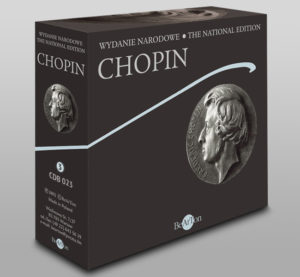
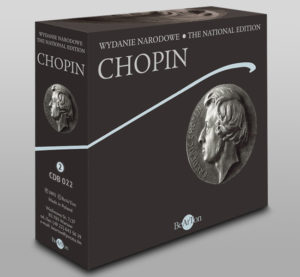
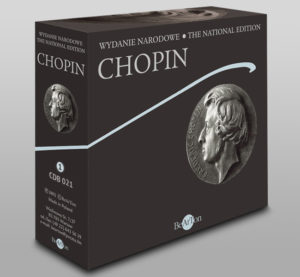
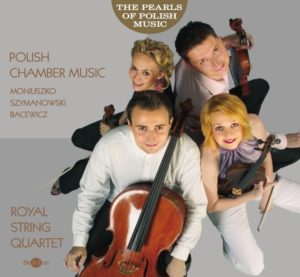
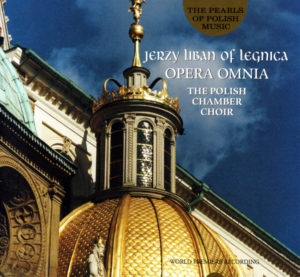
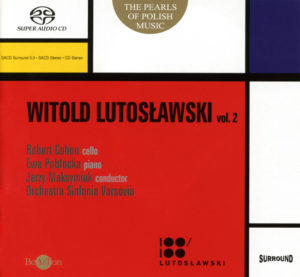
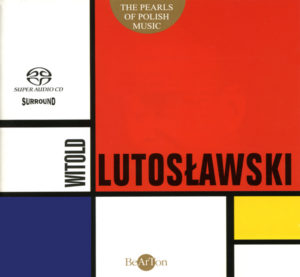
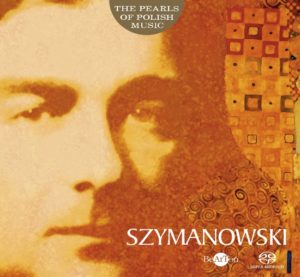
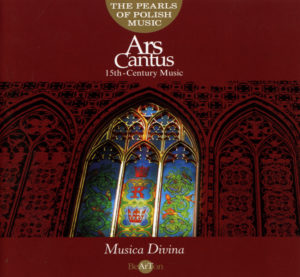
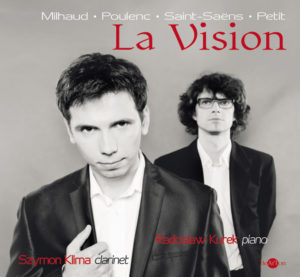
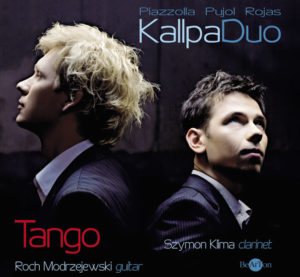
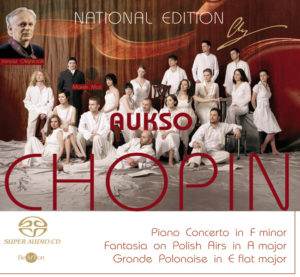
![Chopin – Walce [B] i inne utwory CDB047](https://www.bearton.pl/wp-content/uploads/Chopin-Walce-B-i-inne-utwory-CDB047-A-300x277.jpg)
![Chopin – Pieśni [B] CDB046](https://www.bearton.pl/wp-content/uploads/Chopin-Piesni-CDB046-A-300x277.jpg)
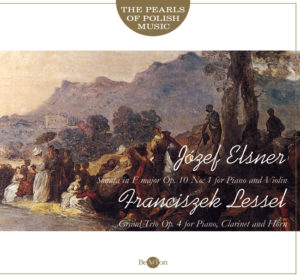

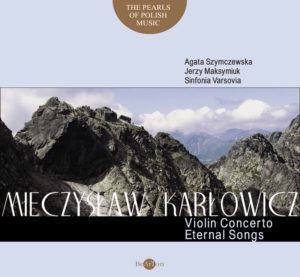
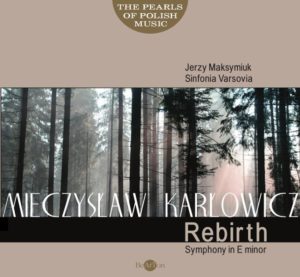
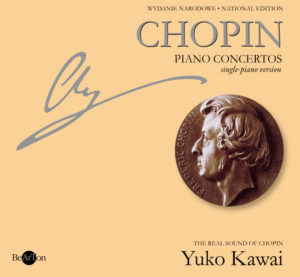
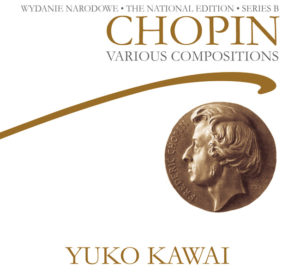
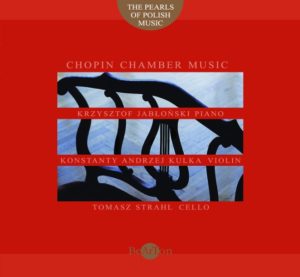
![Chopin - Mazurki i inne utwory [B] CDB038](https://www.bearton.pl/wp-content/uploads/Chopin-Mazurki-i-inne-utwory-B-CDB038-A-300x277.jpg)
![Chopin – Polonezy [B] CDB037](https://www.bearton.pl/wp-content/uploads/Chopin-Polonezy-B-CDB037-A-300x277.jpg)
